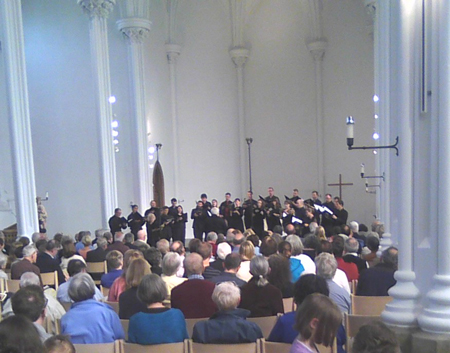by Daniel Hathaway

An unrepentant Roman Catholic, Byrd somehow managed to keep his head on his shoulders while simultaneously writing politically correct music for the English Chapel Royal and supplying Latin liturgical music to clandestine Catholics meeting in homes and private chapels. As a result, we have a large body both of English and Latin music from his pen, much of which — thanks to the new technologies of the period — comes to us in printed editions.
Duffin wove his program in and around Byrd’s Mass for Five Voices, spacing out its Kyrie, Gloria, Credo, Sanctus, and Agnus Dei with motets — like the separation of movements by other liturgical elements in an actual sung mass.
From the festive Sing joyfully to Byrd’s most famous liturgical work, the Ave verum corpus, Quire skilfully made its way through the Latin motets Ne irascaris—Civitas sancti tui, Venite exultemus, In resurrectione tua, Tollite portas, and Haec dicit Dominus, plus an English motet from the Worcester Cathedral Library, Exalt thyself, O God.
Throughout the program, Quire sang with a robust, chiseled sound — the kind of vibrato-less choral tone that reliably carries down the long naves of Gothic cathedrals. Using Elizabethan-Jacobean pronunciation of both English and Latin, Quire proclaimed words with crisp diction except where Byrd’s polyphonic textures made intelligibility impossible. Blend and balance were impeccable.
Quire’s chords rang out razor-sharp in St. Peter’s generous acoustics. Rhythms were finely-etched (especially in the spirited Venite exultemus Domino), and opulent textures ran clear, their individual vocal strands finely differentiated. Soloists moved to the front of the ensemble during some of the Mass movements in graciously choreographed waves.
In so great a corpus of works as Byrd left for later generations of musicians, of course there were motets that individual listeners wished could have been included on this program. For variety’s sake, the luminous Non vos relinquam orphanos might have made an appearance, and the spectacularly virtuosic Vigilate would have sounded splendid coming from the throats of these singers. Considering the wealth of material, maybe Byrd II should be in Quire’s future plans.
Two add-ons enhanced the afternoon’s experience. Kerry McCarthy, author of a recent Oxford University Press biography of the composer, gave a brief and eloquent introduction before joining the alto section for the concert. And Melissa Hubbard, who heads Special Collections at Case Western Reserve University, brought along three partbooks apparently dating from 1613 to exhibit during intermission. They contained two of the motets on Sunday’s program, the treble part of In resurrectione tua so nicely copied out that you could have sung it right off the picture in the printed program.
Oh, and there was one secular item that snuck into the proceedings. Quire responded to the ovation by the large audience with Byrd’s topical madrigal, This sweet and merry month of May.
Published on ClevelandClassical.com May 25, 2016.
Click here for a printable copy of this article



